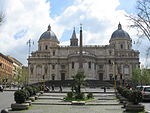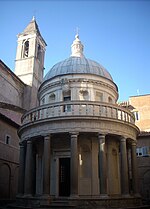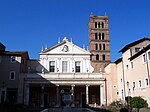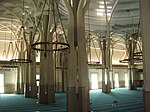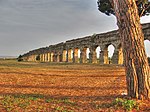| Types |
Building |
Period |
Description |
Picture
|
| Art museum |
Vatican Museums |
16th century |
The Vatican Museums are the public museums of Vatican City, it is the second most visited museum in the world with over 6.5 million visitors a year. The collection on display consists of some of the most famous Roman sculptures and the most important masterpieces of Renaissance art in the world. The collection is divided into ancient (Roman, Etruscan and Egyptian), medieval, Renaissance, Baroque and Rococo, modern and contemporary works of art. |
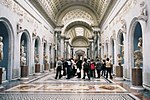
|
| Chapel, art gallery |
Sistine Chapel |
16th century |
Found too in the Vatican City, it contains a huge collection of paintings from all periods, and is Rome's leading and most visited chapel. In 2007, the chapel received 3 million visitors, making it Rome's most popular chapel. |
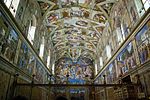
|
| Fountain |
Trevi Fountain |
18th century, Roman Baroque |
One of the most recognizable and iconic monuments in the city, the Trevi Fountain was designed and completed in the 18th century. Tourists come to the fountain in order to throw a coin, which is, according to a local legend, supposed to bring good luck. It was also famous for having featured in a major scene of Federico Fellini's 1960 La Dolce Vita. |

|
| Flight of stairs and public square |
Spanish Steps and Piazza di Spagna |
18th century, Baroque |
One of the city's top attractions, the flight of 138 stairs is the biggest in Europe. They are topped by the Trinita dei Monti church, and below there is the large Piazza di Spagna. The Piazza di Spagna is also a major shopping destination in the city, and hosts several designer boutiques such as Missoni. |

|
| Street |
Via dei Condotti |
Mixture, notably 16th-, 17th- and 18th-century architecture |
Rome's leading shopping street, it contains a wide category of high-fashion or haute-couture boutiques and salons, such as Valentino, Bulgari, Gucci, Dolce & Gabbana, Louis Vuitton, Chanel, Giorgio Armani, Prada and Dior, the headquarters, ateliers or major offices of major flagship labels such as, and also several of the city's finest restaurants, cafes, antique shops and bars. |

|
| Street |
Via del Corso |
Complete mixture |
One of Rome's busiest, biggest and most important streets, the Via del Corso used to be called the Via Lata. It is one of the very few streets in the city to be completely straight, and contains several monuments, palaces, hotels, restaurants, shops and other forms of commerce in general. |

|
| Square |
Piazza del Popolo |
19th century neoclassicism |
A fine example of early Roman neoclassical architecture, the name means "Square of the people", yet its real name derives from the poplar trees which used to line the square. It contains several statues, an obelisk and the Santa Maria del Popolo church. |

|
| Shopping gallery |
Galleria Alberto Sordi |
early-20th century Art Nouveau |
Constructed in Art Nouveau, or Liberty style in 1914, the Galleria Alberto Sordi is an arcaded shopping gallery, and it contains several shops, cafes, bookstores and boutiques. |

|
| Street, talking fountain |
Via del Babuino and il Babuino speaking fountain |
Mixture, notably pre-19th century |
Another of Rome's top shopping streets, it too contains some major fashion boutiques, including Gente, Etro, Emporio Armani and Prada Casual, but also several young designer-wear and knitwear stores, antique shops and jewelers. The street also contains il babuino, one of Rome's speaking fountains (a fountain where several people discuss and voice their political and social ideas). Once, the fountain was covered with political graffiti and different notices, messages and placards, yet, all of this has been removed and anti-graffiti paint has been sprayed around the fountain, since several complained that all the messages and slogans were ruining the appearance of the street. Via del Babuino also contains the Church of England All Saints Church, for Rome's Anglican community. |

|
| Street |
Via Veneto |
Mixture, notably 18th- and 19th-century architecture, and significant Art Nouveau buildings |
One of the city's most expensive, famous and luxurious streets, it was epitomised in the 1950s and 60s in Federico Fellini's 1960 La Dolce Vita. Today, it contains several exclusive apartments, grand hotels and elegant shops. |
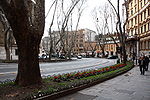
|
| Public square |
Piazza Colonna |
16th-century Renaissance, including some Baroque 18th- and 19th-century buildings |
Originally an ancient Roman square, it currently is flocked by fine Renaissance palazzi and is centred by the ancient Roman Column of Marcus Aurelius. It contains several important governmental and political structures, such as the Palazzo Chigi, the seat of the government of Italy and originally the official embassy of Austria-Hungary. |
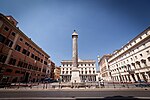
|
| Square |
Piazza Navona |
Relative mixture, predominantly 15th, 16th and 17th century Renaissance and Baroque architecture |
One of the city's best known squares, or piazzas, it is known for its impressive Renaissance and Baroque architecture, several fine buildings, monuments and churches, and numerous open-air bars, pizzerias, restaurants, cafes, stalls and artists. |
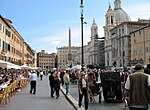
|
| Palace, legal and governmental building |
Palazzo di Giustizia ("Palazzaccio") |
late-19th century, early 20th century neo-Renaissance architecture |
Started in 1889 and completed in 1910, the Palazzo di Giustizia (literally, "Palace of Justice") currently hosts Italy's main law courts. These courts are situated in a grand turn-of-the-century neo-Renaissance palace. |

|
| Square, fountain |
Piazza della Repubblica and the Fontana delle Naidi |
Eclectic, mainly 18th – early-20th century neoclassical architecture |
With a semi-circular formation, this piazza is one of the city's finest neoclassical public squares. Today, the buildings surrounding the square host offices, companies, restaurants, banks and insurance and travel agencies. The middle of the square contains the Fontana delle Naidi, made in 1911 and showing fierce sea-nymphs. |

|
| Cafe |
Antico Caffè Greco |
18th century decor |
A historic and ancient cafe, it was founded in 1760 in the Via dei Condotti, it has 18th and 19th century interior decor. It has hosted several intellectuals and important foreigners, such as Lord Byron, Goethe, Liszt and Keats. |

|
| Villa, art gallery, park and garden |
Galleria Borghese and the Villa Borghese gardens |
16th-17th centuries |
The main villa of the city, once owned by the noble Borghese family and later the Bonapartes (Pauline Bonaparte), it currently is one of Rome's top artistic galleries, and also contains a major park, with several lakes, features, and follies. |

|
| Museums and public square |
Capitoline Museums and the Piazza del Campidoglio |
15th–16th century Renaissance architecture |
Found in the Piazza del Campidoglio on the Capitol Hill, the square and the museums were designed by Michelangelo in 1471. Today, they mainly host ancient Roman and Greek sculptures and works of art. The Piazza del Campidoglio is renowned for its symmetrical Renaissance architecture, and also hosts the Rome city hall. |

|
| Public monument |
Monument of Vittorio Emanuele II |
early-20th century, neo-classical style |
Built in the early 20th century, the Monument, also called the "Altare della Patria" (Altar of the homeland), is one of Rome's most notable monuments. Built in a neo-classical style, with a grandiose flight of stairs and colonnade, it is a controversial monument – its grandeur and pomp has made it often receive the names of "giant type-writer", "wedding-cake" and "zuppa inglese" (an Italian dessert). |

|
| Market-square, open space |
Campo dei Fiori |
Eclectic, notably late-13th-, 14th-, 15th- and 16th-century buildings |
Literally meaning "flower field", due to its status once as a meadow, this public square has for centuries – and still does – serve as an important market-place, and the piazza is flocked with several Medieval and Renaissance palaces and churches. |

|
| Business, public and residential district |
Esposizione Universale Roma (EUR) |
Notably mid-20th century Fascist, late-neoclassical and modernist architecture |
Intended to be the district to host Rome's Universal Exposition, which in the end, never occurred, it was built by Benito Mussolini in the 1930s and '40s, and used to be called the E42. It is often considered one of the best examples of planned Fascist architecture, and is often considered one of the most serene and livable quarters of the city, yet its austere architecture has often arisen to much controversy. |

|
| Palace, political building and residence |
Palazzo del Quirinale |
16th-18th centuries |
The official residence of the President of the Italian Republic, the Qurinial Palace is built in a Renaissance/Baroque architectural style, and boasts elegant Renaissance gardens and a lavish interior. |

|
| Villa and museum |
Villa Giulia and the National Etruscan Museum |
16th century Renaissance |
Found by Pope Julius II in the 1550s, the Villa Giulia is a Renaissance villa, which inside hosts the National Etruscan Museum, filled with several Etruscan and Classical treasures. |

|
| Museum, art gallery |
Galleria Doria Pamphilj |
Roman Baroque |
One of Rome's biggest and most significant private artistic collections, it is currently, and has been owned, by the family of the same name for centuries. |

|
| Ex-mausoleum, later castle and current museum |
Castel Sant'Angelo |
ancient Roman, medieval, Renaissance |
Once the "Mausoleum of Hadrian", it later became a papal residence and currently hosts a major museum. |

|
| Academy, palace, museum and art gallery |
Galleria Nazionale d'Arte Antica and the Accademia dell'Arcadia |
18th century late-Baroque/Rococo |
Consisting of two separate buildings: Palazzo Barberini (formerly owned by the Barberini family) and Palazzo Corsini (rebuilt by the Corsini family in the 1730s and 1740s). It is the main national collection of ancient paintings in Rome. |

|
 The Colosseum, Rome's second and the world's 5th most popular tourist attraction, with 7.7 million tourists a year.
The Colosseum, Rome's second and the world's 5th most popular tourist attraction, with 7.7 million tourists a year.


